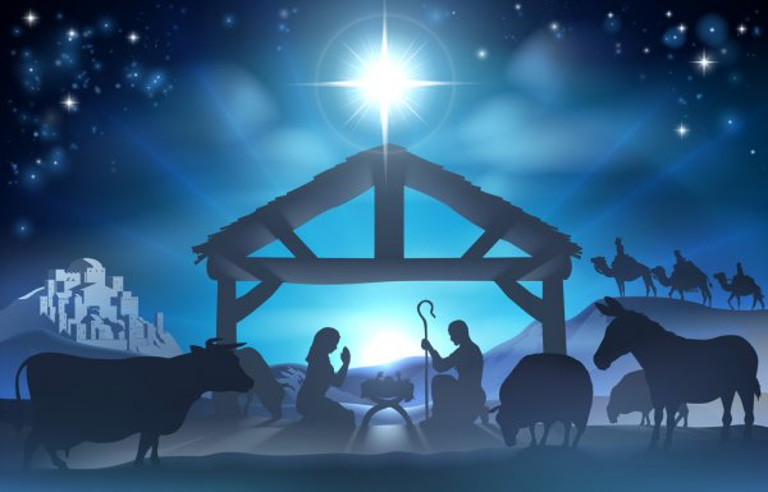East Asian Christmas: Nativity & Celebrations in Japan & Korea
Discover Christmas traditions in Japan and South Korea, from department store Santas to Japan's KFC dinner, and how they differ from Western Nativity celebrations.
5/16/202520 min read
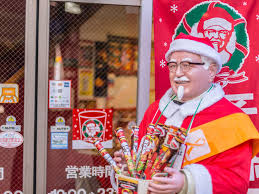

Introduction:
Curious about how Christmas is celebrated in Japan and South Korea? While these countries observe the holiday, their traditions are far from what you might expect if you're used to religious celebrations like in the Philippines or Europe. In Japan, Christmas often means a bucket of KFC chicken, while South Korea embraces the festive spirit with department store Santas. In this guide, I’ll walk you through these countries’ unique secular traditions and explore how, if at all, the Nativity is part of their celebrations. Let’s dive into the Christmas twist in Japan and South Korea!
Secular Christmas Celebrations in Japan
How Santa Claus Became a Symbol of the Holiday in Japan
The KFC Christmas Dinner Phenomenon—Why It’s a Japanese Tradition
Christmas in South Korea: A Blend of Commercialism and Family Time
Nativity and Religious Influences in Japan and South Korea
Unique East Asian Christmas Traditions Beyond Nativity

Secular Christmas Celebrations in Japan
Christmas in Japan is an intriguing mix of Western influence and Japanese cultural adaptations. While the country may not have the same religious ties to Christmas as Western nations, the holiday has become a significant celebration full of joyful festivities. Let's dive into how Christmas is celebrated in Japan today, where the focus is more on secular traditions and community than on religious observances.
Introduction to Christmas in Japan: A Blend of Western Influence and Japanese Culture
In Japan, Christmas is primarily a secular celebration—a time to enjoy festive lights, exchange gifts, and indulge in unique foods. While Christianity is a minority religion in Japan, Christmas traditions, mostly imported from the West, have taken on a distinct local flavor. The holiday isn't marked by the same family-focused, religious observance that you might find in countries like the U.S. or the Philippines. Instead, it’s all about festivities, lights, and commercial charm. From department stores to neighborhood streets, Christmas in Japan is a visual spectacle—a celebration of winter beauty rather than a religious holiday.
How Santa Claus Became a Symbol of the Holiday in Japan
Santa Claus has become the face of Christmas in Japan, even though his arrival isn’t linked to religious celebrations. Santa is a familiar figure in commercials, decorations, and events during the holiday season, embodying the spirit of giving and cheer. Interestingly, while children in Japan may receive gifts, it’s more common to give them Christmas cakes and treats rather than traditional presents. Over the years, Santa has been localized and embraced by Japanese culture as part of the fun, festive atmosphere that surrounds the season.
The Popularity of Christmas Lights and Public Displays in Tokyo and Osaka
When it comes to Christmas lights, Japan doesn’t hold back. In cities like Tokyo and Osaka, illuminations have become a major part of the holiday experience. Winter illuminations are everywhere, lighting up streets, shopping districts, and even entire parks. The displays range from understated to extravagant, with entire areas transformed into sparkling wonderlands. The Shibuya and Shinjuku districts in Tokyo, for example, become magical places during the holiday season, drawing in crowds who want to experience the enchanting glow of these public displays. In a country where aesthetic beauty is highly valued, these Christmas lights aren’t just a spectacle—they’re an art form, and they bring people together to enjoy the season.
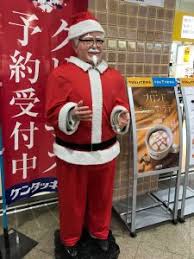

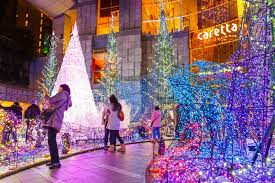

The KFC Christmas Dinner Phenomenon—Why It’s a Japanese Tradition
If you’ve ever wondered why KFC is associated with Christmas in Japan, you’re not alone. It’s a quirky tradition that has taken on a life of its own. The phenomenon started in the 1970s when KFC Japan launched a highly successful marketing campaign promoting fried chicken as the ideal Christmas dinner. What began as a marketing gimmick quickly turned into a nationwide tradition. Nowadays, it’s common for families and couples to enjoy KFC meals on Christmas Eve or Day, often pre-ordered well in advance. It’s seen as a special treat, with many even opting for a Christmas-themed KFC meal complete with cake and festive sides. The idea of enjoying fried chicken on Christmas might seem odd to those from countries where turkey reigns supreme, but in Japan, it’s become a beloved tradition that adds to the holiday’s festive atmosphere.
Christmas Eve as a Romantic Holiday: Dinner Dates and Christmas Illuminations
In Japan, Christmas Eve has evolved into a romantic holiday, often compared to Valentine’s Day. It’s not uncommon for couples to spend the evening having an intimate dinner, exchanging small gifts, and enjoying Christmas illuminations. The idea of romantic intimacy is deeply ingrained in Japanese culture, and on Christmas Eve, couples flock to the most beautifully lit areas of the city to enjoy the magical atmosphere together. Whether it’s a cozy dinner at a high-end restaurant or a stroll under glittering lights, Christmas Eve is often seen as the perfect time for couples to celebrate their relationship. It’s a stark contrast to the family-focused celebrations of Christmas found in many Western countries.
Limited Nativity Presence and How It Contrasts with Western Christmas Celebrations
Unlike in the West, where Nativity scenes are often central to Christmas celebrations, Japan has a limited presence of nativity imagery. The Christmas season here focuses more on the commercial and aesthetic aspects rather than religious ones. You won’t typically see the biblical portrayal of the birth of Jesus in public spaces or homes. Instead, stores, restaurants, and public areas feature Santa Claus, snowflakes, reindeer, and Christmas trees—symbols that are more secular in nature. The lack of a strong religious focus is part of the reason why Christmas in Japan feels more like a winter festival than a religious observance. It’s a celebration of the joy of the season, rather than a religious commemoration of Christ’s birth.
Christmas in Japan is an intriguing blend of Western influence, local adaptations, and a focus on aesthetic enjoyment. From the romanticism of Christmas Eve to the KFC Christmas dinner, the holiday has been reimagined in ways that make it uniquely Japanese. While there may be fewer religious observances, the season still offers a sense of joy, community, and celebration that is distinctly felt throughout the country.
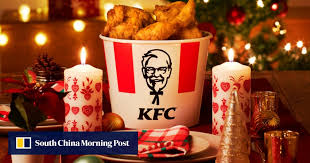

Christmas in South Korea: A Blend of Commercialism and Family Time
In South Korea, Christmas might not be as religiously centered as it is in the West, but it’s still a highly anticipated holiday full of cheer and family traditions. The way Koreans celebrate Christmas has evolved over the years, shaped by a blend of Western customs, local practices, and a dash of commercial spirit. Let's explore how Christmas is observed in South Korea, from gift-giving to holiday lights to a surprising nod to Japanese traditions.
How Christmas is Viewed in South Korea: A Public Holiday, But Not Religious
In South Korea, Christmas is officially a public holiday, but the religious significance is relatively low-key. Christianity is the largest religion in South Korea, but only about 30% of the population identifies as Christian. This means that while many Koreans are aware of the birth of Jesus and may attend church services, Christmas is more of a secular holiday for the majority. Instead of religious observances, Christmas is often seen as an opportunity for family gatherings, gift exchanges, and social events. It’s a time to take a break from work, enjoy a little rest, and embrace the festive spirit of the season.
Department Store Santas and the Role of Santa in South Korean Celebrations
Much like in the West, Santa Claus plays a prominent role in South Korean Christmas celebrations. You’ll see department store Santas in full costume, posing for pictures with families, and even distributing small gifts to children. The image of Santa is embraced mostly as a commercial icon, a way to bring fun and excitement into the holiday season. Santa’s role in Korea isn’t tied to the religious meaning of Christmas but more to the magic and joy of the holiday. Whether in shopping malls, theme parks, or public spaces, Santa is a cheerful figure that adds to the joyful atmosphere of Christmas in South Korea.
How Christmas is Spent: Families, Couples, and Gift-Giving
In South Korea, Christmas isn’t just about family time; it’s also a romantic holiday. Couples often treat Christmas like Valentine’s Day, using it as an occasion for dates, gift exchanges, and quality time together. It’s common for couples to have a romantic dinner at a fancy restaurant, often with holiday-themed decorations and special seasonal menus. On the other hand, families celebrate Christmas in more traditional ways, gathering together for meals and sometimes gift exchanges. While gift-giving is not as extravagant as in Western countries, it’s a lovely gesture to show appreciation. The tradition of giving small gifts like cosmetics, clothing, or holiday-themed treats is widespread.
Christmas Lights and Displays in Seoul: Where to Go for the Best View
When it comes to Christmas lights, Seoul is absolutely dazzling. From late November through December, the city transforms into a winter wonderland, with entire streets and shopping districts aglow in festive lights. The Myeongdong area is particularly famous for its beautiful Christmas lights and displays, attracting locals and tourists alike. The Seoul Plaza also features a massive Christmas tree, and Cheonggyecheon Stream is lined with lights, creating a stunning view at night. These illuminations are not just for aesthetics; they’re also part of the commercial aspect of Christmas in South Korea, drawing shoppers to stores and boosting sales.
South Korea’s KFC Christmas Dinner Tradition (A Nod to Japan)
Just like in Japan, KFC has become the go-to meal for many South Koreans on Christmas. It might sound unusual, but for South Korean families, there’s something about fried chicken that has become synonymous with Christmas celebrations. Many families order KFC for Christmas dinner, and it’s often considered a treat—something special to enjoy together. This tradition, which mirrors the Japanese KFC Christmas dinner phenomenon, reflects how Western commercial influences have shaped South Korean holiday practices. It’s not about turkey or ham—fried chicken is the festive food of choice for a deliciously different Christmas.
The Role of Churches in South Korea: Christmas Services and Nativity Scenes
Though Christmas in South Korea is mostly a secular celebration, churches still play an important role in the holiday. For Christians, attending Christmas Eve services or Christmas Day Mass is an essential part of the season. In addition to services, you might find Nativity scenes set up in churches or public places, giving a nod to the religious origins of Christmas. Many churches in Seoul and other major cities hold special Christmas events, such as choir performances or charity drives, making the holiday more about giving and spiritual reflection. The combination of church services and public displays shows the balance between the secular and religious aspects of Christmas in South Korea.
The Influence of Western Media on South Korean Christmas Customs
It’s impossible to talk about Christmas in South Korea without mentioning the influence of Western media. From Christmas movies like Home Alone to holiday songs on repeat, Western pop culture has had a significant impact on how Koreans celebrate Christmas. Christmas music, especially English-language carols, is a staple in stores, restaurants, and public spaces during the season. The image of Santa Claus and the tradition of Christmas trees are also directly borrowed from Western practices, and they’ve been integrated into South Korean celebrations. Even the concept of Christmas parties at work or school comes from the West, but Koreans have added their own unique twist, often with elaborate buffets and karaoke sessions.
Christmas in South Korea is a fascinating mix of commercialism, family bonding, and a bit of romantic flair. It’s not as deeply rooted in religious traditions as in the West, but it’s no less festive. From KFC dinners to romantic strolls under the lights, South Korea’s version of Christmas is all about making the most of the season, whether that means celebrating with loved ones, enjoying the visual splendor of holiday lights, or embracing the magic of the commercial side of the holiday. It’s a reflection of how global influences can shape a unique celebration of joy and connection.
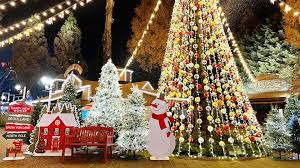

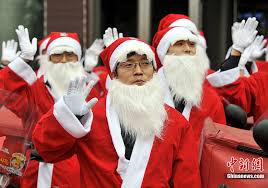

Nativity and Religious Influences in Japan and South Korea
The Nativity story holds deep significance in Christianity, but in Japan and South Korea, the holiday has evolved into something that blends commercialism and modern secular celebrations, often distancing the religious aspects. While Christianity has its roots in both countries, the role of religion in Christmas celebrations is far less prominent compared to more Christian-dominant countries. Let’s dive into how Nativity scenes and religious influences have shaped Christmas traditions in these two countries, and how they balance tradition with modern celebrations.
The Nativity Story in South Korea: How Some Churches Incorporate the Scene Despite Secularization
While Christmas in South Korea is primarily a secular holiday for most people, churches remain a space where the Nativity scene and religious observances play a key role. For Christians in South Korea, the birth of Jesus is central to the meaning of Christmas, and many churches display elaborate Nativity scenes during the holiday season. Even in a society that’s increasingly secular, these religious representations are a way for Christians to affirm their faith and bring the true meaning of Christmas into focus. In fact, the Nativity scene remains one of the most religiously significant symbols in South Korean church celebrations, alongside Christmas Eve Mass, where the story of Jesus' birth is often recounted.
However, outside the church, the presence of the Nativity story is minimal in South Korea’s secular Christmas celebrations. It’s a stark contrast to Western countries, where the Nativity often permeates public life. In South Korea, the emphasis is much more on Santa Claus, gift-giving, and Christmas lights rather than the religious origins of the holiday.
Why Nativity Scenes Are Rare in Japan and South Korea
In Japan, the absence of Nativity scenes is striking. While Japan has a small Christian population, Christmas is largely viewed as a secular celebration. Most people in Japan associate the holiday with Santa Claus, gift-giving, and romantic dinners, with little focus on the religious or biblical origins. The Nativity scene—a staple in many Christian countries—simply isn’t a fixture in Japanese homes or public spaces. Part of this can be attributed to Japan’s cultural and religious landscape, where Shintoism and Buddhism are more prevalent, and Christianity remains a minority faith.
In South Korea, the situation is a bit different, as Christianity is the largest religion. However, even there, the Nativity scene has not fully taken root in public spaces. Christmas is often seen as a family holiday or a romantic occasion for couples, and religious symbols like the Nativity scene are often relegated to churches rather than being integrated into public or family celebrations. Both countries’ commercialized view of Christmas contributes to this lack of religious presence in the public sphere.
The Commercialization of Christmas and Its Impact on Religious Traditions
The commercialization of Christmas in both Japan and South Korea has had a profound impact on the way people view and celebrate the holiday. As Western consumer practices have taken hold, the focus has shifted towards shopping, gift-giving, and holiday-themed events rather than the religious meanings behind Christmas.
In South Korea, department stores, malls, and theme parks are lined with Christmas lights, offering discounts, holding festive events, and even showcasing Santa Claus and reindeer. This shift towards commercial celebration has pushed religious aspects—like the Nativity scene—out of the public eye. For many South Koreans, Christmas is about family time and romantic celebrations, not a reflection on the birth of Jesus.
Similarly, in Japan, Christmas has become more about festive decorations, romantic dinners, and KFC dinners than about Christ’s birth. The commercial aspect of Christmas dominates, and as a result, religious practices surrounding the holiday are rarely seen. The impact of consumer culture has led to a scenario where Christmas is mostly an occasion to indulge in special foods and shopping, not to reflect on religious significance.
Churches in Japan: Celebrating Christmas as a Non-Religious Holiday
In Japan, where less than 1% of the population identifies as Christian, Christmas is largely non-religious. Despite this, some churches do host Christmas Eve services and Christmas Masses. However, these services attract a small audience compared to the country’s overall population. For the minority of Christians in Japan, these services provide a space to observe the religious significance of the holiday, but for the majority, Christmas remains a secular event—an excuse to enjoy lights, food, and festive fun rather than focusing on the birth of Christ.
Churches in Japan may put up a small Nativity scene or host a service, but this is usually limited to Christian communities rather than the general public. Christmas in Japan is not about worship or faith—it’s about celebrating a holiday that has taken on a very commercial and secular identity.
The Rise of Christmas Eve Mass in South Korea: A Growing Trend for Devout Christians
In contrast to Japan, South Korea has seen an increase in the number of people attending Christmas Eve Mass or Christmas Day services. The trend is particularly strong among devout Christians who view Christmas as a deeply spiritual and faith-driven holiday. As Christianity has grown in South Korea, more families are making church attendance a part of their Christmas traditions, and Nativity scenes are becoming more common in churches.
Though Christmas remains a public holiday and secular event for many, there’s a growing movement to reclaim its religious significance. As the number of Christians in South Korea continues to rise, churches are providing a space for worship and celebration that highlights the true meaning of Christmas, despite the overwhelming secularism surrounding the holiday.
How Both Countries Balance Tradition with Modern, Secular Celebrations
In both Japan and South Korea, the balance between traditional religious observances and modern secular celebrations is delicate. While Christmas has become a commercialized holiday in both countries, with Santa Claus, lights, and gift-giving taking center stage, there is also a conscious effort to preserve tradition within the Christian communities.
In South Korea, churches are becoming places for devout Christians to celebrate Christmas in its religious context, while at the same time, families enjoy secular celebrations. In Japan, the influence of Western media has shaped a largely secular holiday, but there are still pockets of Christianity that observe the religious side of Christmas.
Ultimately, both countries have adapted Christmas to fit their unique cultural and religious landscapes, with secular celebrations coexisting alongside religious observances. The balance between tradition and modernity reflects how Christmas in both places has become a complex blend of cultural influences that continue to evolve over time.
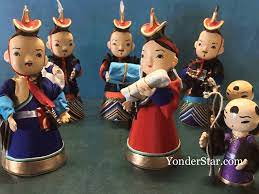

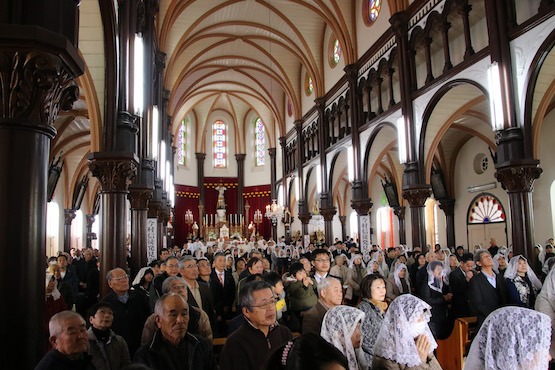

Unique East Asian Christmas Traditions Beyond Nativity
In East Asia, Christmas isn’t just about the Nativity scene or religious observance. It’s become a deeply secular celebration, woven into the cultural fabric of countries like Japan and South Korea in fascinating ways. While Christmas is often seen through the lens of commercialism and consumerism, it has evolved to include some unique traditions that reflect the local culture. From romantic dinners to Christmas cakes, these traditions are as much a part of the holiday season as the typical festive lights and decorations.
Christmas Eve in Japan: Why It’s Celebrated as a Romantic Holiday
In Japan, Christmas Eve is considered more of a romantic holiday than a family occasion. Think Valentine’s Day, but in December. For couples, it’s an opportunity to enjoy a special date night, exchange gifts, and indulge in luxurious dinners. While Christmas Day itself is a less significant day for romance, Christmas Eve is the focal point. Many couples flock to high-end restaurants, exchange gifts, and enjoy the festive atmosphere. It’s not uncommon to see couples strolling through streets lit up with Christmas illuminations or even checking into romantic hotels for a night together. The focus on romance over religious or family celebrations makes Christmas Eve in Japan feel like a unique blend of western influence with a distinctly Japanese flair.
The Popularity of Christmas Cakes in Both Japan and South Korea
One of the most beloved Christmas traditions in Japan and South Korea is the Christmas cake. In Japan, this isn’t just any cake—it’s typically a strawberry shortcake adorned with whipped cream and festive decorations. The tradition of eating a Christmas cake in Japan dates back to the post-World War II era when Western traditions began to make their way into Japanese culture. Koreans, too, have adopted the Christmas cake tradition, though the cakes tend to be more varied in style, from rich chocolate cakes to cakes topped with fruit and cream. Regardless of the variation, these cakes are central to holiday celebrations in both countries and are usually shared among families, couples, and friends. In both cultures, the cake symbolizes joy, togetherness, and a bit of indulgence.
Gift-Giving Traditions: How Presents Are Exchanged and the Cultural Meaning Behind It
Gift-giving during Christmas in Japan and South Korea has its own unique flair. In both countries, Christmas gifts aren’t as extravagant as in some Western nations, but they are still an important expression of appreciation. The most common Christmas presents are small tokens, such as sweets, clothing, or decorative items, with personalized gifts being reserved for closer relationships. In Japan, it’s customary to exchange gifts between couples on Christmas Eve, while in South Korea, it’s a bit more family-oriented, with gifts exchanged between parents and children or among close friends. Gift wrapping also plays an important role in both countries—neatly wrapped presents with elegant designs reflect the importance of presentation in East Asian culture. This gift-giving practice is a way to show respect, gratitude, and goodwill, even if the gifts are relatively modest.
Local Events: Christmas Markets in South Korea and Japan
Both South Korea and Japan have embraced the Christmas market trend in recent years, bringing a touch of European charm to their own holiday celebrations. In Seoul, you can find Christmas markets in places like Hongdae and Gyeongbokgung Palace, where vendors sell holiday crafts, hot chocolate, and seasonal foods. In Tokyo, the Roppongi Hills Christmas Market is a favorite spot, offering German-inspired stalls with mulled wine, roasted chestnuts, and handmade ornaments. These markets have become a place for both locals and tourists to immerse themselves in the festive atmosphere, enjoy seasonal treats, and pick up holiday gifts. They’ve also become a space to celebrate the internationalization of Christmas while adding local twists to the festivities.
Cultural Integration of Christmas Lights: Where to See the Best Illuminations
In both Japan and South Korea, Christmas lights are a significant part of the holiday’s magic. Streets, malls, and public spaces are transformed into illuminated wonderlands, attracting large crowds who come to admire the sparkling displays. In Tokyo, the Shibuya and Omotesando areas are famous for their holiday lights, with entire streets lined with colorful illuminations that create a breathtaking atmosphere. Similarly, in Seoul, the Cheonggyecheon Stream and Lotte World Tower feature elaborate light displays that are a highlight of the holiday season. Whether it’s the romantic glow in Japan’s illuminated parks or the festive sparkle in South Korea’s downtown areas, these light displays are more than just decorations—they’re a form of art and community celebration, where locals gather to enjoy the beauty and joy that lights up the holiday season.
The Commercial Boom of Christmas-Themed Shopping in South Korea
In South Korea, Christmas has turned into a major commercial event, with shopping malls and department stores offering huge discounts, exclusive holiday promotions, and themed events. The Galleria Department Store in Seoul hosts extravagant Christmas-themed events, featuring luxury goods, special holiday collections, and festive décor to attract customers. Pop-up stores and holiday-themed kiosks selling decorations, gifts, and limited-edition items flood the streets in areas like Myeongdong and Gangnam, making it clear that commercial interests have woven themselves into the fabric of South Korea’s holiday celebrations. With K-pop concerts, Christmas sales, and limited-edition products, the holiday season in South Korea is as much about shopping as it is about celebrating. It’s a time when people indulge in the latest fashion, tech, and beauty products, giving rise to a new kind of Christmas tradition rooted in consumerism.
The way Japan and South Korea celebrate Christmas is a reflection of their unique blend of modernity, commercialism, and cultural adaptation. While Nativity scenes might not dominate the holiday as they do in more Christian countries, the influence of Western traditions has shaped local celebrations in fascinating ways. From romantic dinners in Japan to the commercial boom of Christmas shopping in South Korea, these nations have put their own spin on what it means to celebrate the season of giving and joy. Whether it's the allure of Christmas cakes, the spectacle of holiday lights, or the quiet exchange of gifts, Christmas in East Asia is as diverse and multi-dimensional as the cultures that celebrate it.


How Japan and South Korea Celebrate Christmas Overseas
Christmas celebrations in Japan and South Korea may look different from what we’re used to in Christian-majority countries, but even overseas, their unique traditions have a distinct flair. For expats from both countries, Christmas is an opportunity to share their culture and continue cherished holiday traditions, even if they’re far from home. So how do these countries bring their holiday spirit abroad? Let’s explore the ways South Korean and Japanese expats maintain their Christmas traditions and how their culture shapes holiday celebrations in non-Christian countries.
Christmas Celebrations by South Korean and Japanese Expats Abroad
For South Korean and Japanese expats, Christmas is a time to recreate the magic of home and share the warmth of the holiday with their local communities. While the significance of Christmas in their home countries may be less religious, it’s still a time of family gatherings, special meals, and gift-giving. In the U.S., for example, South Korean families will often bring their Christmas cake tradition to the table, while Japanese expats might host intimate Christmas Eve dinners for couples or share Japanese-style Christmas cakes with friends and neighbors. The fusion of local customs with their own celebrations is a hallmark of how expats adapt the holiday. Whether it’s gathering for barbecues in warmer climates or decorating their homes with Christmas lights, the heart of their celebrations stays the same—community, food, and togetherness.
Keeping Secular Christmas Alive in Non-Christian Countries
In countries where Christianity is not the dominant religion, both Japanese and South Korean expats make Christmas about secular fun rather than religious observance. For them, Christmas lights, gift exchanges, and holiday dinners are the essential parts of the celebration. In places like Southeast Asia, where Christmas isn’t traditionally celebrated, these expats often integrate secular Western elements into local holiday festivities. This could mean setting up Christmas trees in their homes or organizing Christmas parties where Japanese and South Korean expats can reconnect with their heritage. They keep the joyful spirit of Christmas alive, even in a place where the religious roots might not be as deeply felt. The goal is not necessarily to celebrate Jesus’ birth, but to enjoy the universal themes of giving, love, and connection that Christmas brings.
Unique Fusion of Local Traditions with Western Elements in Overseas Celebrations
One of the most interesting aspects of Japanese and South Korean Christmas celebrations abroad is how they blend their own holiday traditions with Western influences. In countries like the U.S., Canada, and Australia, both Korean and Japanese expats celebrate Christmas with a fusion of local traditions and their own. For instance, while Westerners are used to traditional Christmas feasts featuring turkey or ham, South Koreans might serve bibimbap or Korean fried chicken at their Christmas gatherings, incorporating a Korean twist on festive meals. Japanese expats may combine Western-style Christmas cakes with sushi or other local dishes to make it uniquely Japanese. At the same time, Western traditions like Santa Claus, Christmas lights, and gift-giving are seamlessly integrated into their celebrations. It’s a beautiful fusion of the old and the new, where traditions from both the East and the West coexist and enrich the holiday season.
How These Countries Export Their Christmas Culture Through Media (K-Dramas, Anime)
One of the most powerful ways South Korea and Japan export their Christmas culture is through the global influence of their media. In the past few years, K-dramas and anime have played a key role in shaping how Christmas is celebrated around the world, even outside of Korean and Japanese communities. Christmas-themed K-dramas are a popular way for Korean expats to share their culture with the world. Shows like “My Lovely Sam Soon” and “Goblin” depict Christmas as a time of romance, family bonding, and magical moments, mirroring the way many South Koreans see the holiday. Similarly, Japanese anime like “Tokyo Godfathers” and “Love Hina” feature Christmas as an opportunity for personal growth, romantic encounters, and heartwarming reunions, subtly infusing Japanese values into the holiday. Through these shows, the world gets a glimpse into the Christmas celebrations and cultural values that are important to Koreans and Japanese, from the romantic emphasis in Japan to the family-oriented spirit in Korea.
Through this media influence, Christmas in Japan and South Korea has become part of the global holiday conversation, blending local customs with Western traditions in ways that transcend geographical boundaries. It’s not just about the holiday itself, but also about sharing a piece of East Asian culture that resonates with people worldwide.
The way South Koreans and Japanese expats celebrate Christmas abroad is a wonderful example of how cultures can adapt and transform holiday traditions. Whether it’s through secular celebrations, blending Western customs with local traditions, or exporting their culture through media, they continue to reimagine Christmas in ways that are both innovative and authentic to their roots. While religion might not be at the forefront of Christmas for these nations, the universal themes of togetherness and joy still shine through in their celebrations, no matter where they are in the world.
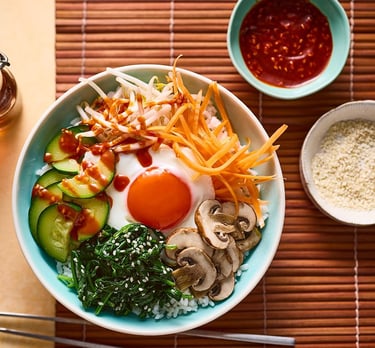

Conclusion:
Though the Nativity story might take a backseat in Japan and South Korea, these countries still find ways to celebrate Christmas in their own unique, secular way. From the surprising Christmas Eve KFC dinner in Japan to the sparkling Christmas lights and department store Santas in South Korea, these traditions create a festive, lighthearted holiday season. So whether you’re in Tokyo’s bustling streets or Seoul’s illuminated parks, Christmas is less about religious observance and more about togetherness, family, and fun. Why not join in the excitement and try something new this year, like a Christmas cake or a walk through Tokyo’s neon-lit holiday streets?
